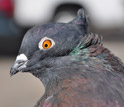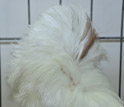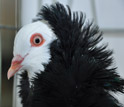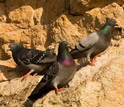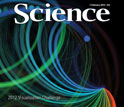News Release 13-013
Mutant Gene Responsible for Pigeons' Head Crests
Decoded genome reveals secrets of pigeon traits and origins
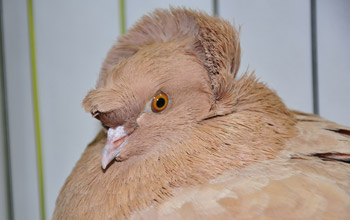
Head ornamentation called a shell crest is seen on this English trumpeter rock pigeon.
January 31, 2013
This material is available primarily for archival purposes. Telephone numbers or other contact information may be out of date; please see current contact information at media contacts.
Scientists have decoded the genetic blueprint of the rock pigeon, unlocking secrets about pigeons' Middle East origins, feral pigeons' kinship with escaped racing birds and how mutations give pigeons traits like feather head crests.
"Birds are a huge part of life on Earth, but we know surprisingly little about their genetics," says Michael Shapiro, one of the study's two principal authors and a biologist at the University of Utah.
In the new study, "we've shown a way forward to find the genetic basis of traits--the molecular mechanisms controlling animal diversity in pigeons," he says. "Using this approach, we expect to be able to do this for other traits in pigeons, and it can be applied to other birds and many other animals as well."
The findings appear in a paper published this week in the online journal Science Express.
Shapiro conducted the research with Jun Wang of China's BGI-Shenzhen (formerly Beijing Genomics Institute) and other scientists from BGI, the University of Utah, Denmark's University of Copenhagen and the University of Texas M.D. Anderson Cancer Center in Houston.
"The research identified the genes contributing to variation in the avian head crest, using the domesticated pigeons that so fascinated and inspired Charles Darwin in developing his theory of natural selection," says George Gilchrist, program director in the National Science Foundation's (NSF) Division of Environmental Biology, which funded the research. "This finding illustrates the power of comparative genomics."
Pigeons were domesticated some 5,000 years ago in the Mediterranean region. Key results of this study include sequencing of the genome of the rock pigeon Columba livia, which is among the most common bird species.
There are some 350 breeds of rock pigeons--all with different sizes, shapes, colors, color patterns, beaks, bone structure, vocalizations and arrangements of feathers on the feet and head--including head crests in shapes known as hoods, manes, shells and peaks.
The pigeon's genetic blueprint is among the few bird genomes sequenced so far, along with those of the chicken, turkey, zebra finch and a common parakeet known as a budgerigar or budgie. "This will give us new insights into bird evolution," Shapiro says.
Using software developed by paper co-author Mark Yandell, a geneticist at the University of Utah, the scientists revealed that a single mutation in a gene named EphB2 causes head and neck feathers to grow upward instead of downward, creating head crests.
"This same gene in humans has been implicated as a contributor to Alzheimer's disease, as well as prostate cancer and possibly other cancers," Shapiro says, noting that more than 80 of the 350 pigeon breeds have head crests, which play a role in attracting mates in many bird species.
The researchers compared the pigeon genome to those of chickens, turkeys and zebra finches. "Despite 100 million years of evolution since these bird species diverged, their genomes are very similar," Shapiro says.
A genome for the birds, a gene for head crests
The biologists assembled 1.1 billion base pairs of DNA in the rock pigeon genome; the researchers believe there are about 1.3 billion total, compared with 3 billion base pairs in the human genome. The rock pigeon's 17,300 genes compare in number with the approximately 21,000 genes in humans.
The researchers first constructed a "reference genome"--a full genetic blueprint--from a male of the pigeon breed named the Danish tumbler.
Shapiro says the study is the first to pinpoint a gene mutation responsible for a pigeon trait, in this case, head crests.
"A head crest is a series of feathers on the back of the head and neck," Shapiro says. "Some are small and pointed. Others look like a shell behind the head; some people think they look like mullets. They can be as extreme as an Elizabethan collar."
The researchers found strong evidence that the EphB2 (Ephrin receptor B2) gene acts as an on-off switch to create a head crest when mutant, and no head crest when normal.
They also showed that the mutation and related changes in nearby DNA are shared by all crested pigeons, so the trait evolved just once and was spread to numerous pigeon breeds by breeders.
Full or partial genetic sequences were analyzed for 69 crested birds from 22 breeds, and 95 uncrested birds from 57 breeds. The biologists found a perfect association between the mutant gene and the presence of head crests.
They also showed that while the head crest trait becomes apparent in juvenile pigeons, the mutant gene affects pigeon embryos by reversing the direction of feather buds--from which feathers later grow--at a molecular level.
Other genetic factors determine what kind of head crest each pigeon develops: shell, peak, mane or hood.
Tracking the origins of pigeons
A 2012 study by Shapiro provided limited evidence of pigeons' origins in the Middle East and some breeds' origins in India and indicated kinship between common feral or free-living, city pigeons and escaped racing pigeons.
In the new study, "we included some different breeds that we didn't include in the last analysis," Shapiro says. "Some of those breeds only left the Middle East in the last few decades. They've probably been there for hundreds if not thousands of years. If we find that other breeds are closely related to them, then we can infer those other breeds probably also came from the Middle East."
The scientists found that the owl breeds--pigeon breeds with very short beaks that are popular with breeders--likely came from the Middle East. They're closely related to breeds from Syria, Lebanon and Egypt.
The research also uncovered a shared genetic heritage between breeds from Iran and breeds likely from India, consistent with historical records of trade routes between those regions. People were not only sharing goods along those routes, but probably also interbreeding their pigeons.
As for the idea that free-living pigeons descended from escaped racing pigeons, Shapiro says his 2012 study was based on "relatively few genetic markers scattered throughout the genome. We now have stronger evidence based on 1.5 million markers, confirming the previous result with much better data."
The scientists analyzed partial genomes of two feral pigeons: one from a U.S. Interstate-15 overpass in Utah's Salt Lake Valley, the other from Lake Anna in Virginia.
"Despite being separated by 1,000 miles, they are genetically very similar to each other and to the racing homer breed," Shapiro says.
"Darwin used this striking example to communicate how natural selection works," he says. "Now we can get to the DNA-level changes that are responsible for some of the diversity that intrigued Darwin 150 years ago."
The study's co-authors from the University of Utah include Yandell, Eric Domyan, Zev Kronenberg, Michael Campbell, Anna Vickery and Sydney Stringham; Chad Huff is a co-author from the University of Texas.
The study was also funded by the Burroughs Wellcome Fund, the University of Utah Research Foundation, the National Institutes of Health and the Danish National Research Foundation.
-NSF-
-
An Indian fantail--one of 350 rock pigeon breeds--displays a head crest called a peak crest.
Credit and Larger Version -
A Jacobin rock pigeon has a head crest known as a hood that hides the bird's face.
Credit and Larger Version -
A rock pigeon of the breed old Dutch capuchine has a head crest resembling a mane.
Credit and Larger Version -
Feral rock pigeons perched on cliffs near Norfolk in the U.K.
Credit and Larger Version -
The research team's results are described in the Feb. 1 issue of the journal Science.
Credit and Larger Version
Media Contacts
Cheryl Dybas, NSF, (703) 292-7734, email: cdybas@nsf.gov
Lee Siegel, University of Utah, (801) 581-8993, email: lee.siegel@utah.edu
The U.S. National Science Foundation propels the nation forward by advancing fundamental research in all fields of science and engineering. NSF supports research and people by providing facilities, instruments and funding to support their ingenuity and sustain the U.S. as a global leader in research and innovation. With a fiscal year 2023 budget of $9.5 billion, NSF funds reach all 50 states through grants to nearly 2,000 colleges, universities and institutions. Each year, NSF receives more than 40,000 competitive proposals and makes about 11,000 new awards. Those awards include support for cooperative research with industry, Arctic and Antarctic research and operations, and U.S. participation in international scientific efforts.
Connect with us online
NSF website: nsf.gov
NSF News: nsf.gov/news
For News Media: nsf.gov/news/newsroom
Statistics: nsf.gov/statistics/
Awards database: nsf.gov/awardsearch/
Follow us on social
Twitter: twitter.com/NSF
Facebook: facebook.com/US.NSF
Instagram: instagram.com/nsfgov



